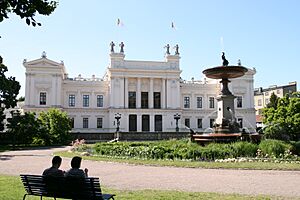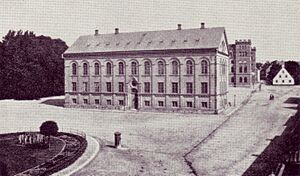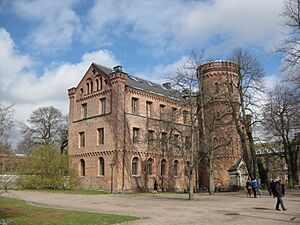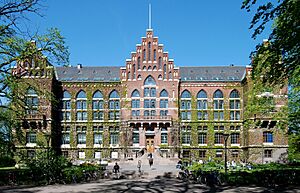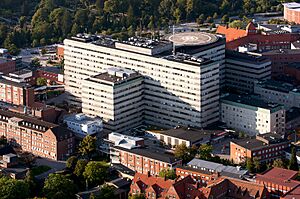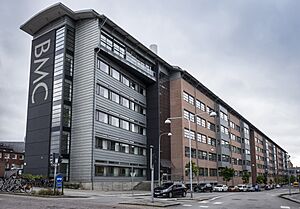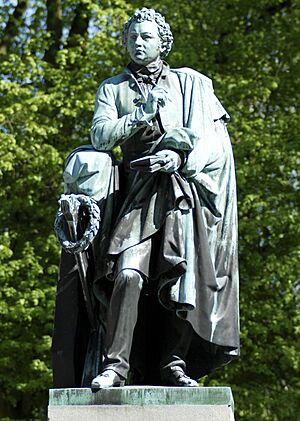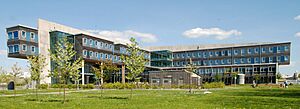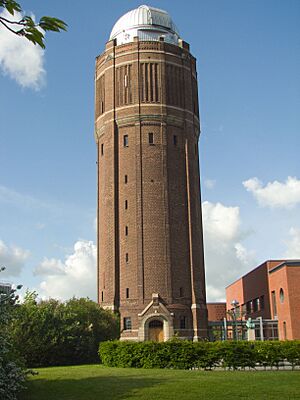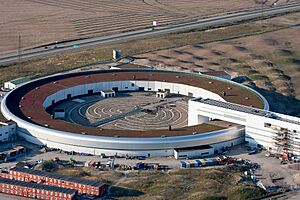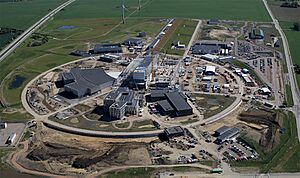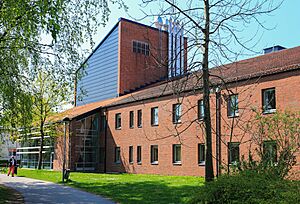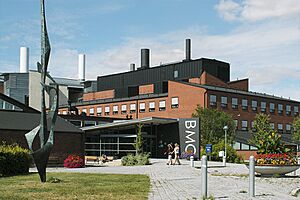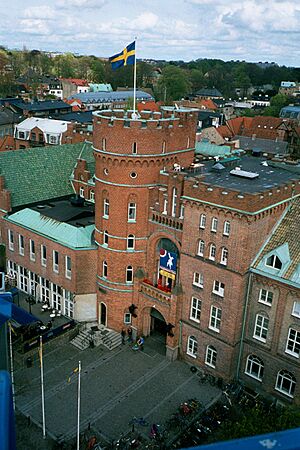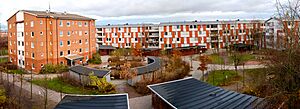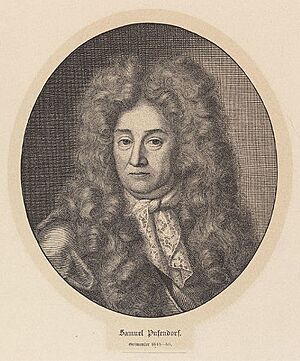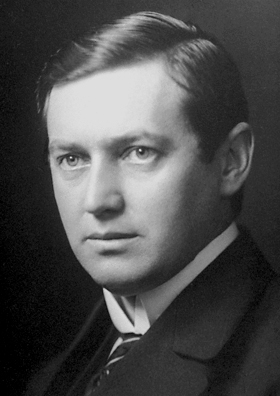Lund University facts for kids
|
Lunds universitet
|
|
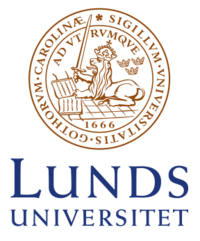 |
|
| Latin: Universitas Lundensis | |
|
Former name
|
Royal Caroline Academy Latin: Regia Academia Carolina |
|---|---|
| Motto | Ad utrumque |
|
Motto in English
|
Prepared for both |
| Type | Public research university |
| Established | 1666 |
| Budget | SEK 10.4 billion |
| Vice Chancellor | Erik Renström |
|
Academic staff
|
5,050 (2023) |
|
Administrative staff
|
3,000 (2023) |
| Students | 47,000 (27,000 FTE) |
| Location |
,
,
Sweden
|
| Campus | Urban |
| Colors | Dark blue and bronze |
| Nickname | LU |
| Affiliations | Universitas 21 LERU EUA ASAIHL |
| Website | https://www.lu.se https://www.lunduniversity.lu.se |
Lund University (Swedish: Lunds universitet) is a big public university in Sweden. It is one of the oldest universities in Northern Europe. The university is in the city of Lund in the Swedish area called Scania. It was officially started in 1666. Before that, there was an old school called a studium generale near Lund Cathedral.
Lund University has nine main parts called faculties. It also has campuses in Malmö and Helsingborg. About 47,000 students study there in many different programs and courses. The university works with 560 other universities in about 70 countries. It is part of important groups like the League of European Research Universities and the global Universitas 21 network. Many famous people have been connected to Lund University, including five Nobel Prize winners and a Fields Medal winner.
Two big research places for materials have been built in Lund recently. One is MAX IV, a special lab that helps scientists see tiny things. It opened in 2016. The other is European Spallation Source (ESS), which will be a very powerful neutron research facility. It is expected to be fully working by the end of 2027.
The university's main area is around the Lundagård park, which is next to the Lund Cathedral. Many departments are spread out in the city. A large part of the university, including the Faculty of Engineering, is located north of the park, connecting to the university hospital area.
Contents
History of Lund University
Early Beginnings
The city of Lund has always been a place for learning. It was an important religious center in Denmark long ago. A school for training priests, called the Katedralskolan, started there in 1085. It is now the oldest school in Scandinavia.
In 1425, a type of medieval university called a studium generale was founded in Lund. It was next to the Lund Cathedral. This made it the oldest place for higher education in Scandinavia. However, this old school did not continue after the Lutheran Reformation in 1536. That is why the university founded in 1666 is seen as a new beginning.
From the 1600s to the 1800s
After Sweden took over the Scania region from Denmark in 1658, the university was started in 1666. The goal was to help make Scania more Swedish by educating teachers and connecting the region with Sweden. The university was first called Academia Carolina after King Charles X Gustav of Sweden. This name was used until the late 1800s. Lund University was the fifth university under the Swedish king at that time.
When it started, the university had four main study areas: Law, Theology, Medicine, and Philosophy. These were the core subjects for over 200 years. In the late 1600s, about 100 students attended. Some important early professors included Samuel Pufendorf, who studied law history.
The Scanian War in 1676 caused the university to close until 1682. It reopened thanks to people from the region. However, it did not become very famous until the 1800s. There were not many classrooms, so lessons were sometimes held in the Lund Cathedral. Professors were not paid very well.
In 1716, King Charles XII of Sweden stayed in Lund for two years. This brought some attention to the city and the university. After the king's death in 1718, the university received more money. The number of students grew to about 500. Even though it was not as big as Uppsala University, it became well-known and attracted good professors.
Around 1760, the university's reputation went down, and fewer than 200 students attended. But by 1780, it became popular again. This was thanks to great teachers, especially in language studies. A very famous professor named Esaias Tegnér attracted many students to Lund. One of them was C. G. Brunius, who later became a professor and helped redesign many buildings in Lund.
In 1829, a serious incident involving students happened at a university residence. This event led to discussions about student life and helped create the Akademiska Föreningen (Academic Society) in the 1830s.
In 1845 and 1862, Lund hosted student meetings with the University of Copenhagen. A student named Elsa Collin was the first woman in Sweden to perform in a student comedy show called a spex.
The 1900s and Today
In the early 1900s, only about a thousand students attended the university. Most were from wealthy families and studied to become civil servants, lawyers, or doctors. In the following years, the university grew a lot and became one of Sweden's largest. In 1964, the social sciences became a separate faculty. The Lund Institute of Technology started in 1961 and joined Lund University eight years later.
Lund University has become very popular for students applying to Swedish universities, both from Sweden and other countries. For studies starting in autumn 2012, Lund received over 11,000 applications from international master's students. This was about one-third of all international applications to Swedish universities.
Women at the University
The first woman to study in Lund was Hildegard Björck in 1880. She had already been the first Swedish woman to get a university degree. Soon after, Hedda Andersson also started studying medicine in Lund in 1880. She is often called the first woman at Lund University because she stayed longer.
Hilma Borelius was the first woman to earn a doctorate degree in Lund in 1910. In 1965, Birgitta Odén became the first woman professor in history. Boel Flodgren became the head of Lund University in 1992. She was the first woman to lead a European university.
University Campus
Most of the university's buildings are in the city of Lund. Lund is about 15 km from Malmö and 50 km from Copenhagen. With so many students and staff, Lund feels like a university town. Over a hundred university buildings are spread around the city. Many are in an area stretching northeast from Lundagård park in the city center. Buildings near Lundagård include the main building, Kungshuset, the Historical Museum, and the Academic Society's main office. The main library is a short walk north, followed by the large hospital.
Lund University also has a campus in nearby Malmö, which is Sweden's third-largest city. The Malmö Art Academy, Malmö Academy of Music, and Malmö Theatre Academy are all located there. The university also does a lot of research and medical training at Skåne University Hospital in Malmö.
Campus Helsingborg is in the city of Helsingborg, about 50 km from Lund. It opened in 2000 and is in a building next to the train station and harbor. Nearly 3,000 students study there.
The School of Aviation (LUSA) teaches flying at an airfield near Ljungbyhed, about 40 km from Lund.
University Museums
The Biological Museum is a research collection with millions of plant and animal specimens. It was started in 1735 by Kilian Stobaeus, a teacher of Carl Linnaeus. The museum has collections of plants, insects, and animals. It is especially rich in specimens from Sweden and other Nordic countries.
University Library
Lund University library started in 1668, at the same time as the university. It is one of Sweden's oldest and largest libraries. Since 1698, it has received a copy of every book printed in Sweden. Today, only Lund and the Royal Library in Stockholm are required to keep everything forever. The library has a huge collection of books and other materials.
The main library building, designed by Alfred Hellerström, opened in 1907. It was named Sweden's most beautiful building in 2019. The old library building, Liberiet, is near the city's cathedral. It was built as a library in the 1400s but is now a cafe.
University Hospital
Medical education and research at the university happen with Skåne University Hospital. This hospital has locations in both Lund and Malmö. Medical classes are held in the Biomedical Centre in Lund. Other health sciences, like nursing and occupational therapy, have moved to the new Forum Medicum building. The university also has the Clinical Research Centre in Malmö, which has many special labs.
Student Housing
LU Accommodation helps students find places to live in Lund, Malmö, and Helsingborg. They offer different types of rooms, including dorm rooms and apartments.
How Lund University is Organized
Leadership
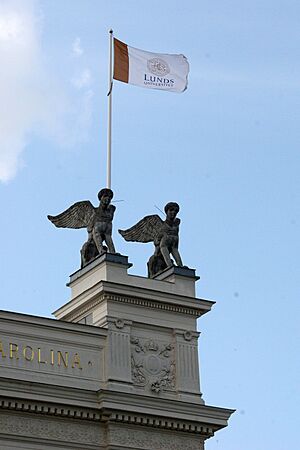
The University Board is the highest decision-making group. It includes the Vice-Chancellor, teachers, students, and people from the community and businesses. The Vice-Chancellor and the University Management Group lead the daily operations.
Main Study Areas (Faculties)
Lund University has nine main faculties:
- Faculties of Humanities and Theology
- Faculty of Engineering (LTH)
- Faculty of Fine & Performing Arts
- Faculty of Law
- Faculty of Medicine
- Faculty of Science
- Faculty of Social Sciences
- School of Aviation
- School of Economics and Management
Research Centers
The university also has more than 20 special institutes and research centers. Some examples are:
- Lund University Centre for Sustainability Studies (LUCSUS)
- Biomedical Centre
- Centre for Chemistry and Chemical Engineering - Kemicentrum
- Centre for European Studies
- MAX lab - for physics research
- Raoul Wallenberg Institute of Human Rights and Humanitarian Law
Learning and Discoveries
Education at Lund
The university offers about 275 study programs and 1400 courses. Many programs are taught in English, which is great for international students. In 2021, Lund offered 6 of the 10 most popular master's programs in Sweden. Five of these were at the School of Economics and Management.
Amazing Research
Lund University is known as one of the biggest research universities in Scandinavia. It publishes many scientific papers and gets a lot of research money from the European Union. The university does important research in areas like brain science, tiny technology (nanotechnology), climate change, and stem cell biology.
Cool Inventions from Lund
Many important inventions have come from research at Lund University. One of the most famous is diagnostic ultrasound, which doctors use every day to see inside the body. Other amazing inventions include:
- The artificial kidney, which helps people with kidney problems.
- Bluetooth technology, which lets devices talk to each other wirelessly.
Here are some other discoveries from Lund over the years:
- 1847: Ice Age theory
- 1887: The Rydberg constant (in physics)
- 1926: The first respirator (breathing machine)
- 1946: The artificial kidney
- 1953: Medical ultrasound
- 1956: Figuring out the number of human chromosomes
- 1957: Discovery of dopamine (a brain chemical)
- 1966: Asthma medicine
- 1967: Nicorette (to help people stop smoking)
- 1972: The Inkjet printer
- 1994: Bluetooth
- 2005: Hövding invisible cycling helmet
- 2012: The world's most water-efficient shower
- 2018: Suture-TOOL, a surgical device
University Rankings
| University rankings | |
|---|---|
| Global – Overall | |
| ARWU World | 101–150 (2024) |
| QS World | 75 (2025) |
| RUR World | 55 (2024) |
| THE World | 95 (2025) |
| USNWR Global | =125 (2025) |
Lund University is often ranked among the top 100 universities in the world. Many of its subjects are in the top 50. In 2025, it was ranked 75th in the world by QS World University Rankings, making it the top university in Sweden. It is also very popular with international students.
In 2021, QS World University Rankings by Subject placed Lund in the top 50 for: Geography (24th), Development Studies (32nd), Environmental Sciences (44th), and Nursing (47th).
Student Life
Student life at Lund is built around three main groups: the student nations, the Academic Society (AF), and the student unions. Students can choose to join these groups.
Student Nations
The nations are a big part of the university's history. They used to be like dorms for students from different parts of Sweden. Östgöta Nation, the oldest, started in 1668. Today, they are more like student clubs.
Students can join any nation they like. Each nation offers different activities. They have some student housing, but it is limited. Most nations have a pub night and a nightclub each week. They also host fancy student balls once a year. Many nations also have weekly dinners. All activities are run by student volunteers.
The Academic Society (AF)
In 1830, Professor Carl Adolph Agardh started Akademiska Föreningen (The Academic Society), or AF. Its goal was to bring students and teachers together. Prince Oscar helped fund the society. In 1848, they started building AF-borgen (the AF Fortress). This building is still a center for student life in Lund. AF has theater groups, a student radio station (Radio AF), and organizes the huge Lundakarnevalen (Lund Carnival) every four years. AF also helps manage over 5,700 student homes in Lund.
Student Unions
Student unions speak for students in university decisions. They also help students with their rights, housing, and career choices. There are nine student unions, one for each faculty, and one for doctoral students.
The unions are part of the Association of Lund University Student Unions (LUS). LUS has full-time representatives who meet with the university's leaders. LUS also runs services like a loan office and a daycare center. It publishes the monthly Lundagård magazine.
Famous People from Lund University
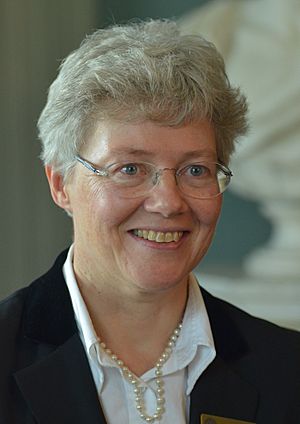
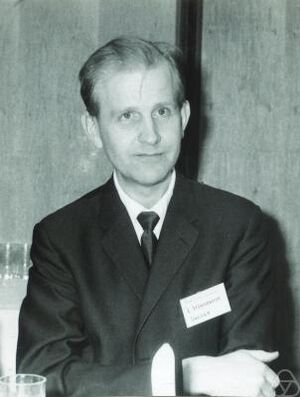
Many important people have studied or worked at Lund University. They have been involved in many great achievements, such as:
- Five Nobel Prizes
- A Fields Medal (a top math award)
- Creating the first implantable pacemaker
- Developing echocardiography (ultrasound for the heart)
- Discovering the role of dopamine in the brain
- Developing Bluetooth technology
Here are some notable people:
Humanities and Economics
- Samuel Pufendorf (1632–1694): A famous thinker who influenced Adam Smith.
- Knut Wicksell (1851–1926): An important economist.
- Bertil Ohlin (1899–1979): Won the Nobel Prize in economics in 1977.
- Torsten Hägerstrand (1916–2004): A world-famous geographer.
Biology and Medicine
- Carl Linnaeus (1707–1778): The "father of modern taxonomy" (how we classify living things).
- Pehr Henrik Ling (1776–1839): Considered the "father of Swedish massage" and modern physical therapy.
- Nils Alwall (1904–1986): Built the first practical dialysis machine.
- Rune Elmqvist (1906–1996): Developed the first implantable pacemaker.
- Inge Edler (1911–2001): Developed medical ultrasonography (echocardiography) in 1953.
- Sune Bergström (1916–2004) and Bengt Samuelsson (1934–): Won the Nobel Prize in Physiology or Medicine in 1982.
- Arvid Carlsson (1923–2018): Won the Nobel Prize in Physiology or Medicine in 2000 for discovering the role of dopamine.
Math, Engineering, and Science
- Johannes Rydberg (1854–1919): A famous physicist known for the Rydberg formula.
- Manne Siegbahn (1886–1978): Won the Nobel Prize in Physics in 1924 for X-ray research.
- Hellmuth Hertz (1920–1990): Developed echocardiography and inkjet printing technology.
- Lars Hörmander
 (1931–2012): Won the Fields Medal in 1962 for his work in math.
(1931–2012): Won the Fields Medal in 1962 for his work in math. - Sven Mattisson (1955–): One of the developers of Bluetooth technology.
- Anne L'Huillier (1958-): A professor who won the Nobel Prize in Physics in 2023.
Politics and Law
- Ernst Wigforss (1881–1977): Sweden's finance minister for many years.
- Tage Erlander (1901–1985): Sweden's prime minister for a very long time (1945–1969).
- Ingvar Carlsson (1934–): Served as Sweden's prime minister.
- Rupiah Banda (1937–): Was the president of Zambia.
- Marianne Lundius (1949–): The first female president of the Supreme Court of Sweden.
Literature and Culture
- Esaias Tegnér (1782–1846): An influential writer and poet.
- Viktor Rydberg (1828–1895): A famous writer of the 1800s.
- Frans G Bengtsson (1894–1954): Famous for his novel The Long Ships.
- Hans Alfredsson (1931–2017): A well-known Swedish comedian and author.
- Axwell (Born Axel Christofer Hedfors, 1977–): A world-famous DJ and member of Swedish House Mafia.
Business and Entrepreneurship
- Hans Rausing (1926–2019): Was the head of Tetra Pak, a big packaging company.
- Pehr G. Gyllenhammar (1935–): A businessman who led Volvo.
- Bertil Hult (1941–): Founded EF Education from his dorm room at Lund.
- Stefan Persson (1947–): Was the CEO and chairman of H&M.
Partner Universities
Lund University works with universities all over the world for research and student exchange.
Some partners include the University of California, Nanyang Technological University, Heidelberg University, and the University of Tokyo.
The university is also part of European programs like Erasmus and Nordplus. It also leads several international projects. Lund University is an active member of the University of the Arctic, a network of universities focused on education and research in the Arctic region.
See also
 In Spanish: Universidad de Lund para niños
In Spanish: Universidad de Lund para niños
- Fernström Prize
- List of early modern universities in Europe
- Royal Swedish Physiographic Society in Lund


